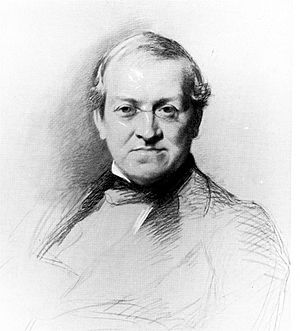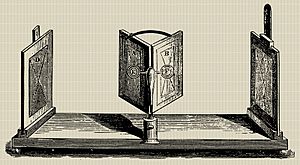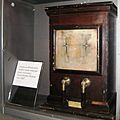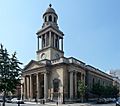Charles Wheatstone facts for kids
Quick facts for kids
Charles Wheatstone
|
|
|---|---|

Wheatstone,
drawn by Samuel Laurence in 1868 |
|
| Born | 6 February 1802 Barnwood, Gloucestershire, England
|
| Died | 19 October 1875 (aged 73) Paris, France
|
| Known for | Wheatstone bridge Wheatstone–Playfair cipher Wheatstone system Wheatstone ABC telegraph Cooke and Wheatstone telegraph Kaleidophone Potentiometer Pseudoscope Stereoscope Early contributions to Spectroscopy |
| Awards | Royal Medal (1840, 1843) Albert Medal (1867) Copley Medal (1868) |
| Scientific career | |
| Fields | Physics |
| Institutions | King’s College London |
Sir Charles Wheatstone FRS (born 6 February 1802 – died 19 October 1875) was an amazing English scientist and inventor. He created many important things during the Victorian era, a time when Queen Victoria ruled England.
Some of his most famous inventions include the English concertina (a musical instrument), the stereoscope (a device that makes pictures look 3D), and the Playfair cipher (a secret code). Wheatstone is also well known for helping to develop the Wheatstone bridge, which measures electrical resistance, and for his big role in creating the telegraph, which sent messages over long distances using electricity.
Contents
His Life Story
Charles Wheatstone was born in Barnwood, a town in Gloucestershire, England. His father sold music and later became a flute teacher in London. Charles was the second son. He went to different schools, and one of his teachers was amazed at how quickly he learned!
As a boy, Charles was very shy. He loved to go to an attic by himself and think. When he was about 14, he started working for his uncle, who made and sold musical instruments. But Charles preferred reading books and studying science over making things or doing business. His father saw this and let him leave his uncle's shop.
Early Discoveries
When he was 15, Charles translated French poetry and even wrote two songs! He loved buying books, especially about science. One day, he really wanted a book about Alessandro Volta's discoveries in electricity, but he didn't have enough money. He saved his pennies until he could buy it.
The book was in French, so he saved up again to buy a dictionary! Then, with his older brother William, he started doing the experiments described in the book. They even made their own battery in the scullery (a small kitchen room) behind their house. When they ran out of copper plates for the battery, Charles had a clever idea: "We must use the pennies themselves!" And it worked!
Charles Wheatstone married Emma West in 1847. She passed away in 1866, leaving him with five young children. Even though he was quiet in public, Charles was a lively talker when he was with friends and discussing his favorite topics.
He was knighted in 1868 for his work on the automatic telegraph. He received many awards and honors from different scientific groups around the world. He was a member of the Royal Society and the French Academy of Sciences.
In 1875, while visiting Paris, he caught a cold that turned into a serious lung illness. He passed away in Paris at 73 years old. His body was brought back to London and buried in Kensal Green Cemetery.
Music and Sound Inventions
In 1821, Wheatstone showed off his "Enchanted Lyre" at a music shop. It looked like a lyre hanging from the ceiling, playing music from different instruments like the piano and harp. But it was a trick! The lyre was just a box, and a steel rod connected it to instruments playing out of sight.
Wheatstone studied how sound travels. He realized that sound moves in waves, just like light. He even thought about sending sound signals, music, or speech over long distances using solid rods. He called this idea a "telephone," long before the modern telephone was invented!
He also created a simple device to make quiet sounds louder, which he called a "Microphone." It was different from the electrical microphones we use today.
In 1823, Charles and his brother William took over their uncle's musical instrument business. Charles wasn't keen on the business side, but he loved making improvements to instruments and inventing new ones. One of his most famous inventions was the Wheatstone concertina, a six-sided instrument with 64 keys.
In 1827, he invented the "kaleidophone," a device that made the vibrations of a sound visible. It had a metal rod with a silver bead that reflected a spot of light. As the rod vibrated, the light spot would draw amazing patterns in the air.
In 1834, Wheatstone became a professor of Experimental Physics at King's College London. He was so shy that his first lectures on sound were a disaster! He would sometimes turn his back to the audience and mumble to his diagrams. He was much more comfortable working in his laboratory.
Measuring Electricity's Speed
In 1834, Wheatstone became famous for a big experiment: measuring how fast electricity travels through a wire. He set up a wire with a gap in the middle where a spark could jump. He connected the wire to a Leyden jar (a device that stores electricity). This created three sparks: one at each end of the wire and one in the middle.
He used a tiny mirror that spun very fast to watch the sparks. If the sparks happened at the exact same time, their reflections would appear in a straight line. But the middle spark appeared a tiny bit later. This showed that electricity took a small amount of time to travel from the ends of the wire to the middle. By measuring this tiny delay and how fast the mirror spun, he could calculate the speed of electricity. His results were very close to the actual speed of light!
Seeing Colors in Light
Wheatstone also helped develop spectroscopy, which is the study of how light breaks down into different colors. In 1835, he showed that when metals were heated in an electric spark, their light, when viewed through a prism, showed specific colors that were unique to each metal. This meant you could tell what metals were present by looking at the light they produced. This idea was very important for later scientists who used it to discover new elements and learn about stars!
The Telegraph Revolution
Wheatstone eventually stopped working on sending messages with vibrating rods and started focusing on the electric telegraph. In 1835, he said that the tools already existed to make an electric telegraph very useful to the world.
Working with Cooke
In 1837, a man named William Fothergill Cooke visited Wheatstone. Cooke had seen a telegraph demonstration and wanted to make a working telegraph system. He lacked scientific knowledge, so he was sent to Wheatstone.
They decided to work together. Wheatstone brought his scientific knowledge, and Cooke handled the business side. They got a patent for their inventions, including Wheatstone's five-needle telegraph. This telegraph used five needles that would point to letters on a diamond-shaped dial to spell out messages.
First Telegraph Lines
Their first experimental telegraph line was set up in London in 1837, running between Euston and Camden Town railway stations. Wheatstone was at Euston, and Cooke was at Camden Town. When Wheatstone sent the first message and heard the needles click, he felt a huge thrill, knowing his invention was truly working!
Even though it worked, the railway company wasn't very interested at first. But in 1839, the Great Western Railway used their telegraph to connect Paddington station to West Drayton, a distance of about 13 miles (21 km). People could pay a shilling to see this amazing invention that could send messages so quickly.
Public Excitement
The public really started to notice the telegraph in 1845. A murderer named John Tawell was caught because of telegraph messages sent between towns. This was the first time telecommunications technology led to an arrest!
Wheatstone kept improving the telegraph. He created "single" and "double" needle instruments. The single-needle instrument, which only needed one wire, is still used today. The telegraph developed so fast that in 1855, news of the Emperor of Russia's death in St. Petersburg reached the House of Lords in London just a few hours later!
More Telegraph Inventions
Wheatstone also thought about telegraph cables under the sea. In 1844, he successfully sent signals through an insulated wire submerged in Swansea Bay. The next year, he suggested using gutta-percha (a type of rubber) to coat the wire for a cable across the English Channel.
In 1840, Wheatstone patented an "alphabetical telegraph" that showed letters on a dial. He also invented the first telegraph that could print messages in type in 1841.
Later, Wheatstone invented the "automatic transmitter." This machine let people punch out messages onto a paper strip (punched tape). This strip was then fed into the sending machine, which sent the signals much faster than a human could. This allowed telegraphs to send about 100 words a minute, and later even 600 words a minute! This system was a very early version of what became the stock market ticker tape.
Making Things Look 3D
In 1838, Wheatstone was the first to describe how our eyes see in 3D, a process called stereopsis. He realized that our brain combines two slightly different pictures from each eye to create an impression of depth. This led him to invent the stereoscope. This device uses lenses or mirrors to combine two photos of the same object, taken from different angles, making the object appear solid and 3D.
In 1852, he invented the "pseudoscope," which was the opposite of the stereoscope. It made solid objects look hollow and close objects look far away! He used it to test his ideas about how we see in 3D.
Measuring Time Precisely
In 1840, Wheatstone created his "chronoscope" to measure tiny amounts of time, like the speed of a bullet. This machine used an electric current to make a mark on moving paper, recording the exact moment something happened. It could measure time down to a tiny fraction of a second!
He also worked on electric clocks. In 1840, he showed an electro-magnetic clock and had a plan to send the correct time from one main clock to many other clocks using electricity.
The Wheatstone Bridge
In 1843, Wheatstone wrote an important paper about measuring electrical resistance. He described a special circuit called the Wheatstone bridge. Even though another scientist named Samuel Hunter Christie first thought of it, Wheatstone made it famous and showed how useful it was for measuring unknown electrical resistances.
He also created a unit of resistance and showed how to use it to measure the length of a wire based on its resistance.
Secret Codes
Wheatstone was also very clever at inventing secret codes, or ciphers. He created the Playfair cipher, named after his friend Lord Playfair. This code was used by armies in several countries, even during World War I and II! It was very hard to crack at first.
He also invented a "cryptograph," a machine that could turn a message into a secret code that only another matching machine could decode.
Electrical Generators
In 1840, Wheatstone developed a machine that could generate continuous electric currents using magnets.
In 1867, he also published ideas about how dynamo-electric machines (which generate electricity) work. It turned out that other scientists had similar ideas around the same time, showing how many great minds were working on electricity back then!
Images for kids
-
Wheatstone English concertina
-
A double-needle telegraph instrument used on the Great Western Railway
See also
Template:KIDDLE XL START  In Spanish: Charles Wheatstone para niños Template:KIDDLE XL END
In Spanish: Charles Wheatstone para niños Template:KIDDLE XL END
- William Fothergill Cooke
- Oliver Heaviside







